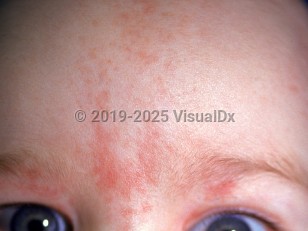Salmon patch in Adult
Alerts and Notices
Important News & Links
Synopsis

The salmon patch, also known as stork bite, angel's kiss, nevus simplex, and erythema nuchae, is the most common vascular lesion seen in infants of all races and ethnicities (20%-60%), usually at birth. The nape of the neck and occiput are the most common sites, but facial, scalp, and sacral lesions are frequent. The trunk and limbs are less often affected. There may be multiple lesions. Lesions enlarge in proportion to the child's growth. Facial lesions generally fade within 1-2 years, whereas those at other sites, especially nuchal, persist into adulthood.
A variant of the salmon patch known as the butterfly-shaped mark can occur in the sacral region. Sacral lesions may be associated with spinal dysraphism, tethered cord, lipomeningocele, or diastematomyelia, usually when another skin defect occurs (a dimple, sinus, swelling, excess hair, nevus, or skin aplasia).
A variant of the salmon patch known as the butterfly-shaped mark can occur in the sacral region. Sacral lesions may be associated with spinal dysraphism, tethered cord, lipomeningocele, or diastematomyelia, usually when another skin defect occurs (a dimple, sinus, swelling, excess hair, nevus, or skin aplasia).
Codes
ICD10CM:
Q82.5 – Congenital non-neoplastic nevus
SNOMEDCT:
254211001 – Salmon patch nevus
Q82.5 – Congenital non-neoplastic nevus
SNOMEDCT:
254211001 – Salmon patch nevus
Look For
Subscription Required
Diagnostic Pearls
Subscription Required
Differential Diagnosis & Pitfalls

To perform a comparison, select diagnoses from the classic differential
Subscription Required
Best Tests
Subscription Required
Management Pearls
Subscription Required
Therapy
Subscription Required
References
Subscription Required
Last Updated:03/07/2021
 Patient Information for Salmon patch in Adult
Patient Information for Salmon patch in Adult
Premium Feature
VisualDx Patient Handouts
Available in the Elite package
- Improve treatment compliance
- Reduce after-hours questions
- Increase patient engagement and satisfaction
- Written in clear, easy-to-understand language. No confusing jargon.
- Available in English and Spanish
- Print out or email directly to your patient
Upgrade Today

Salmon patch in Adult

